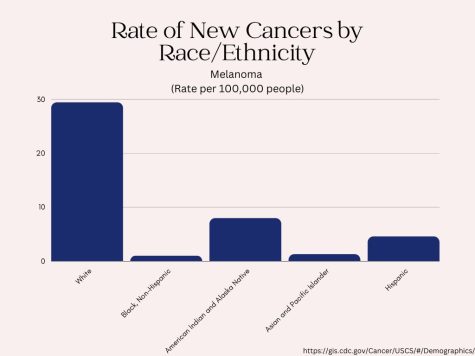
Twitter: @kyralu05
February 8, 2023
Imagine a warm and sunny day; it is perfect for sitting outside and having an ice-cold glass of water, relaxing on a beach chair. The pleasant sun rays absorbing into the skin give immediate ease, and it is tempting to stay there all day.
However, that exact sun could also potentially kill you.
Ultraviolet (UV) rays come from the sun, tanning beds, and sunlamps which causes exposure to skin cancer in many people. These invisible rays damage the skin cells by reaching inner skin layers, which is also referred to as sunburn, and can ultimately lead to skin cancer.
Even though it is preventable when caught early, the risk is significant enough to take precautions when spending time outdoors. According to the American Academy of Dermatology Association, it is estimated that one in five Americans will develop skin cancer in their lifetime.
The sun is more complex than one might think. There are three types of UV rays: ultraviolet A (UVA), ultraviolet B (UVB), and ultraviolet C (UVC).
“UVA and UVB rays have different effects on our skin. UVB is what causes sunburn and skin damage, while UVA is the cause of skin aging, such as wrinkles,” said board-certified dermatologist Dr. John Zade.

The difference between UVA and UVB rays depends on their wavelength. UVA radiation has a longer wavelength and is slightly less intense than the other but penetrates deeper into the skin. UVC radiation is the most harmful and has the shortest wavelength, but it gets absorbed by the atmosphere, so it does not affect people as much unless exposed to an artificial source.
“You want to have a sunscreen that protects your skin from both UVA and UVB rays,” Zade said.
In order for the sunscreen to block out both different types of rays, it must offer broad-spectrum protection. A product must be labeled as broad-spectrum to tell people the amount of protection that it has.
Additionally, both of these rays are the strongest in the middle of the day, from about 10 a.m. to 4 p.m., because the sun is fully out. To help with the evaluation of how strong the rays will be, the U.S. National Weather Service and Environmental Protection Agency created the UV Index, which goes from a scale of 1 to 11-plus, where a higher number indicates stronger UV rays and how much faster people experience damage to the skin.
The UV Index warns people about the need for sun protection and informs them of how much time to spend in the sunlight.
Despite their harmfulness, sunlight and UVB rays have many practical purposes.
“The sun is super important. You need it for Vitamin D, and dermatologists even use specific wavelengths of UVB light to treat skin conditions, such as vitiligo and psoriasis,” said board-certified dermatologist Dr. Jason Chouake. “UVB light is a very powerful tool to treat specific skin conditions and even certain skin cancers.”
UV light therapy can reduce skin illness symptoms and slows down the production of skin cells by using fluorescent lights that emit specific wavelengths of light.
In addition, any person of any age can have a light therapy procedure, even babies. However, restrictions may occur if someone has certain medical conditions, such as pregnancy or having forms of skin cancer.
One form of protection from UV rays is sunscreen. Everyone needs it. At all ages, anyone can be exposed to skin cancer, no matter their gender or skin tone. Even babies over the age of six months should start using sunscreen every day. Not only does it prevent skin cancer, but also early skin aging.
“Sunscreen acts like a filter and absorbs some of the UV light before it reaches the skin,” Chouake said.
It creates a layer of protection between the skin and the sun, and it either absorbs or reflects the sunlight depending on the type of sunscreen.
Sun Protection Factor (SPF) in sunscreen is a measure of how much more protection a product has against the amount of UVB radiation that causes redness on unprotected skin, according to Chouake. It is recommended to use SPF 30 or higher and to reapply every two hours because higher numbers in SPF indicate more protection.
There are two different types of sunscreen: physical and chemical. According to Zade, physical blockers have compounds of zinc oxide and titanium dioxide, and they create an actual barrier or shield between the skin and the sun.
Chemical sunscreens contain ingredients such as avobenzone, octinoxate, and oxybenzone, and instead of reflecting the rays as physical sunscreens do, it absorbs them.
It is very important to wear either sunscreen every single day, not just when going to the beach. Due to the weather associated with the beach, people connect sunscreen with only extremely sunny conditions. However, the sun reaches beyond that.
“The sun still affects people. Even if it looks dark outside, you should still use your sunscreen because the UVA and UVB radiation still gets through the clouds,” Zade said. “You might think, ‘Oh, it’s cloudy and I’m not getting any sunlight’, but you are still getting the radiation. Make it part of your routine when you wake up to wear your sunscreen.”
These harsh UV rays can cause a variety of skin illnesses, including skin cancer, which is the most common type of cancer in the United States.
Honoure Stark, someone who has had skin cancer for over 10 years, describes her struggles.
“The hardest thing I have to face is that it constantly interrupts my day and things I plan in the future,” Stark said. “I have to treat my skin cancer as part of my lifestyle.”
As part of her everyday life, treatments and checkups are frequent.
“There is a cream I use for daily treatment, and it goes right into my immune system,” Stark said. “It basically attacks the skin cancer cells.”
In addition to the minimum protection people need from the sun, she has to be even more careful by adding extra protection.
For example, clothing is another form of protection other than using sunscreen. Long sleeve shirts, pants, or anything that covers the skin and blocks the sun. Generally, darker colors provide better protection than lighter color clothing. This means that some absorb more UV rays than others, which prevents the likelihood of the rays reaching your skin.
“Physical protection is really the best form of protection because there is actually a physical barrier between the skin and the sun,” Chouake said.
Fortunately, there is clothing that is specifically designed for sun protection against the sun.
“There is sun protective clothing, which is called Ultraviolet Protection Factor (UPF) clothing. You should be wearing sunscreen on non-exposed skin, but you could also wear things that cover your skin,” Zade said.
UPF clothing ranges from long sleeve shirts to pants and even accessories.
“I wear UV products like an armband,” Stark said. “When you are driving, your left arm gets exposed to a lot of the sun.”
Certain individuals have a higher risk of developing skin cancer, especially if they have burn injuries, the tendency to burn easily, and a significant amount of sun exposure. People with lighter skin tones are also more prone to developing skin cancer, but all people, regardless of skin tone, are at risk.
“My mother was never told that because I am a redhead, I am very susceptible to all skin cancer. I never wore hats or sunscreen as a child, so I would come back from swimming and have extreme sunburns,” Stark said.
People with less melanin, or pigment, in their skin, are less protected from the damage of UV radiation because melanin helps block out UV rays.
“Because I am a redhead, I have interesting cell structure and skin,” Stark said. “On a skin scale, I am at zero because I don’t have any melanin.”
However, early detection can greatly increase the chances of curing it. By using the first five letters of the alphabet, melanoma can be identified.
Another way of identifying melanoma is through the Ugly Duckling. All moles look about the same, and finding one that is an odd one out can be a sign. For example, a large and dark mole that sticks out in a series of small and light moles.
Protecting the skin as early as possible greatly decreases the chance of getting skin illnesses, but that should not keep people from going outside.
“Don’t miss an opportunity to have a wonderful outdoor memory, but for sure put something between you and the sun,” Stark said.
